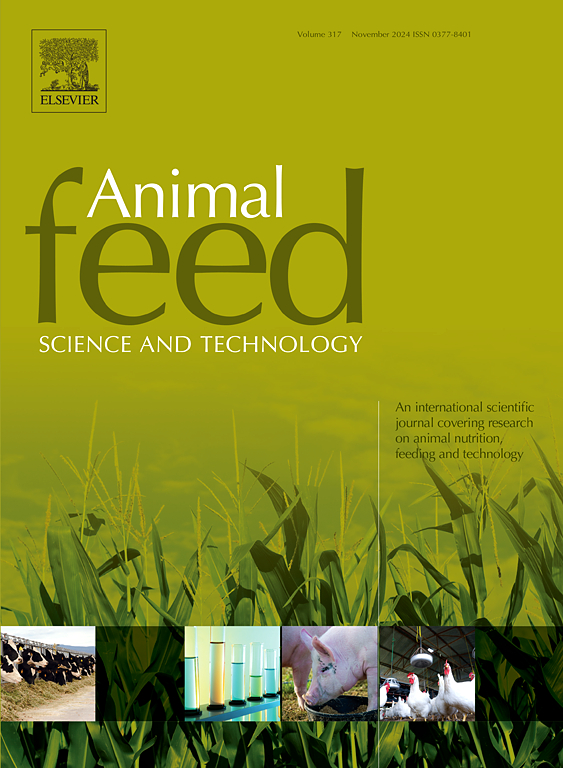Growth, oxidative stress, and intermediary metabolism of European seabass (Dicentrarchus labrax) juveniles fed diets including solid-state fermented distiller's dried grains with solubles
IF 2.5
2区 农林科学
Q1 AGRICULTURE, DAIRY & ANIMAL SCIENCE
引用次数: 0
Abstract
Previous research demonstrated that solid-state fermentation (SSF) of distiller's dried grains with solubles (DDGS) by Aspergillus ibericus improved protein, reduced neutral and acid detergent fiber levels, and added phenolic compounds, xylanase, and cellulase. Fermentation of DDGS also increased protein, lipids, energy, and starch digestibility. This study evaluated the effects of unfermented and fermented DDGS on growth, oxidative stress, and intermediary metabolism of European seabass (Dicentrarchus labrax) juveniles. Five different diets were prepared: a control diet without DDGS and four with 10 % or 20 % unfermented or fermented DDGS (diets 10DDGS, 20DDGS, 10SSF-DDGS, and 20SSF-DDGS). Each diet was fed to triplicate seabass (30 ± 5 g) for 12 weeks. The 10SSF-DDGS diet increased the protein efficiency ratio, final body weight, and nitrogen retention (% N intake) compared to the 10DDGS diet, with no differences from the control diet. Both 20 % DDGS diets reduced growth performance, but the 20SSF-DDGS diet showed higher feed and protein utilization than the 20DDGS diet. Whole-body composition was unaffected except for 20SSF-DDGS, which had lower dry matter, lipids, protein, and gross energy content. The 10SSF-DDGS diet reduced hepatic glucose-6-phosphate dehydrogenase activity, while the 20SSF-DDGS diet decreased amino acid catabolism enzyme activity and increased glucokinase and pyruvate kinase activity. In intestinal oxidative status, 10DDGS reduced superoxide dismutase and increased glutathione reductase, glutathione peroxidase, and lipid peroxidation, whereas the 10SSF-DDGS diet mirrored the control diet. In conclusion, SSF of DDGS enhances feed utilization and maintains intestinal oxidative status, particularly at lower inclusion levels, highlighting its potential as an improved alternative to unfermented DDGS in aquafeeds. However, further research involving long-term trials, thermal stress challenges in the context of climate change, and disease resistance assessments is necessary to confirm its broader applicability in aquaculture.
饲料中添加固体发酵酒糟和可溶性物的欧洲鲈鱼幼鱼的生长、氧化应激和中间代谢
以往的研究表明,用伊比拉曲霉(Aspergillus ibericus)对干酒糟进行固体发酵(SSF)可以提高蛋白质水平,降低中性和酸性洗涤纤维水平,并添加酚类化合物、木聚糖酶和纤维素酶。发酵DDGS还能提高蛋白质、脂肪、能量和淀粉的消化率。本研究研究了未发酵和发酵的DDGS对欧洲鲈鱼幼鱼生长、氧化应激和中间代谢的影响。制备了5种不同的饲粮:不含DDGS的对照饲粮和添加10% %或20% %未发酵或发酵DDGS的4种饲粮(10DDGS、20DDGS、10SSF-DDGS和20SSF-DDGS)。每种饲料投喂3尾鲈鱼(30 ± 5 g) 12周。与对照饲粮相比,10SSF-DDGS饲粮提高了蛋白质效率、最终体重和氮沉积(% N摄入量),与对照饲粮无差异。20 % DDGS组均降低了生长性能,但20SSF-DDGS组的饲料和蛋白质利用率高于20DDGS组。除干物质、脂质、蛋白质和总能量含量较低的20SSF-DDGS外,全身成分未受影响。10SSF-DDGS组降低了肝脏葡萄糖-6-磷酸脱氢酶活性,20SSF-DDGS组降低了氨基酸分解代谢酶活性,提高了葡萄糖激酶和丙酮酸激酶活性。在肠道氧化状态中,10DDGS降低了超氧化物歧化酶,增加了谷胱甘肽还原酶、谷胱甘肽过氧化物酶和脂质过氧化,而10SSF-DDGS日粮与对照日粮基本相同。综上所述,DDGS的SSF提高了饲料利用率,维持了肠道氧化状态,特别是在较低的添加水平下,突出了其作为水产饲料中未发酵DDGS的改进替代品的潜力。然而,需要进一步的研究,包括长期试验、气候变化背景下的热应力挑战和抗病性评估,以确认其在水产养殖中的更广泛适用性。
本文章由计算机程序翻译,如有差异,请以英文原文为准。
求助全文
约1分钟内获得全文
求助全文
来源期刊

Animal Feed Science and Technology
农林科学-奶制品与动物科学
CiteScore
6.00
自引率
6.20%
发文量
266
审稿时长
3 months
期刊介绍:
Animal Feed Science and Technology is a unique journal publishing scientific papers of international interest focusing on animal feeds and their feeding.
Papers describing research on feed for ruminants and non-ruminants, including poultry, horses, companion animals and aquatic animals, are welcome.
The journal covers the following areas:
Nutritive value of feeds (e.g., assessment, improvement)
Methods of conserving and processing feeds that affect their nutritional value
Agronomic and climatic factors influencing the nutritive value of feeds
Utilization of feeds and the improvement of such
Metabolic, production, reproduction and health responses, as well as potential environmental impacts, of diet inputs and feed technologies (e.g., feeds, feed additives, feed components, mycotoxins)
Mathematical models relating directly to animal-feed interactions
Analytical and experimental methods for feed evaluation
Environmental impacts of feed technologies in animal production.
 求助内容:
求助内容: 应助结果提醒方式:
应助结果提醒方式:


